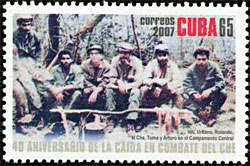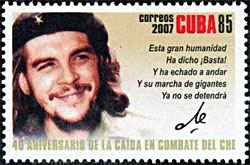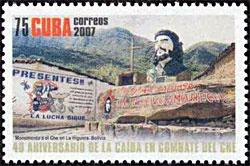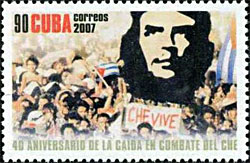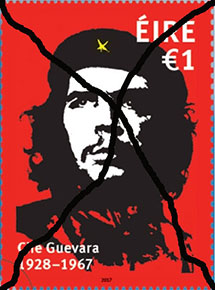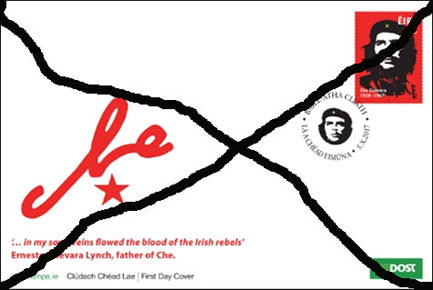![]()
[It is] relentless hatred of the enemy that impels us over and beyond the natural limitations
of man and transforms us into effective, violent, selective, and cold killing machines.
Che GuevaraIn August of 1960, a year and a half after Che Guevara entered Havana ahead of his "column" of "guerrillas," Time magazine featured the revolutionary comandante on its cover and crowned him the "Brains of the Cuban Revolution." (Fidel Castro was "the heart" and Raul Castro "the fist.") "Wearing a smile of melancholy sweetness that many women find devastating," read the Time article, "Che guides Cuba with icy calculation, vast competence, high intelligence and a perceptive sense of humor." "This is not a Communist Revolution in any sense of the term," The New York Times had declared a year earlier. "Fidel Castro is not only not a Communist, he is decidedly anti-Communist."
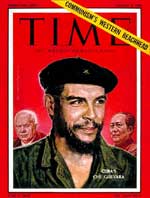 |
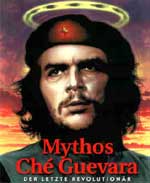 |
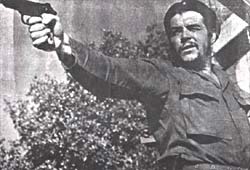 |
Time magazine was in perfect sync with her major-media peers -- utterly wrong. Guevara was no more the brains of the Cuban Revolution than Cheka-head Felix Dzerzhinsky had been the brains of the Bolshevik Revolution, or Gestapo chief Himmler the brains of the National Socialist Revolution, or KGB head Beria the brains behind Stalinism. In fact Che performed the same role for Fidel Castro as Dzerzhinsky performed for Lenin, Himmler for Hitler and Beria for Stalin. Che Guevara was the Castro regime’s chief executioner. Under Che, Havana's La Cabana fortress was converted into Cuba's Lubianka. He was a true Chekist: "Always interrogate your prisoners at night," Che commanded his prosecutorial goons, "a man is easier to cow at night, his mental resistance is always lower."
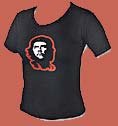 |
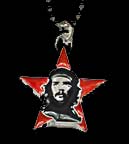 |
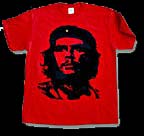 |
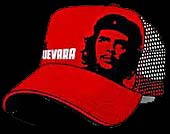 |
Vengeance, much less justice, had little to do with the Castro/Che directed bloodbath in the first months of 1959. Che's murderous agenda in La Cabana fortress in 1959 was exactly Stalin's murderous agenda in the Katyn Forest in 1940. Like Stalin's massacre of the Polish officer corps, like Stalin's Great Terror against his own officer corps a few years earlier, Che's firing squad marathons were a perfectly rational and cold blooded exercise that served their purpose ideally.
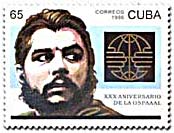 |
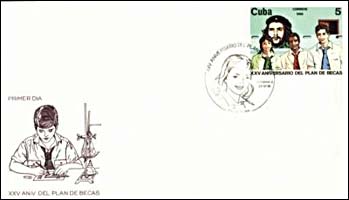 |
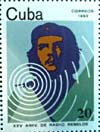 |
As Minister of Industry, Che pushed a massive industrialization scheme (which failed), supporting widespread state construction of high-polluting thermoelectric plants, refineries and factories. Fast forward forty years, and Che shirt-wearing anarchists and environmentalists take to the streets, expounding the social and environmental evils of industrialization. Those same Che shirt-wearing radicals shake their fists at the nuclear weapons arsenal of America. Unfortunately, its people like Che who forced the free countries to have such an arsenal. During the Cuban missile crisis, Che was the biggest advocate for Cuba actually pushing the button. “We must proceed along the path of liberation even if that costs millions of atomic victims,” Che said in an article written during the crisis.
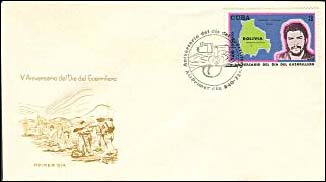 |
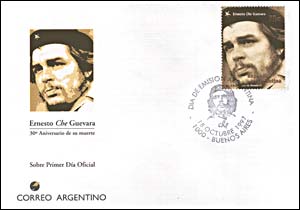 |
Guevara was made a Cuban citizen (as he was originally from Argentina) and an official at the National Institute of Agrarian Reform, president of the National Bank of Cuba, and Minister of Industries. From these posts he directed Cuba’s transition to a Soviet-style economic system. In propaganda this meant creating the fair and efficient economy of the future; in practice this meant wholesale redirection of millions of lives, arrogance, and devastation. In “Notes on Man and Socialism” he wrote “to build communism, you must build new men as well as the new economic base.” Molding the Cuban people in accordance with his own Stalinist vision was his goal, and now he had the power to make whatever sacrifices of other peoples’ time, energy, and lives he thought necessary.
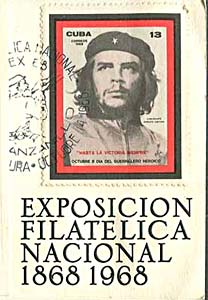 |
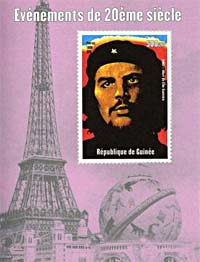 |
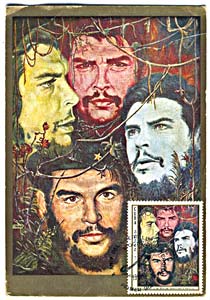 |
Individual tastes and talents could not be allowed to stand in the way of the revolution. Contrary opinions had to be silenced, and they were. Counterrevolutionary elements were put in “labor camps,” “re-educated,” or imprisoned without trial, many being executed. These were not merely agitators in the employ of robber barons. These were vagrants, drunks, idlers, Christians, poets, and many other classes, including “Cuban youth…who had to go into hiding to listen to [rock albums] which the Revolution, and [Guevara] and his cohorts, dubbed as ‘imperialist music’.”
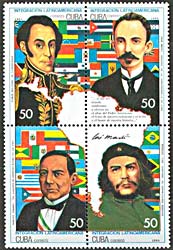 |
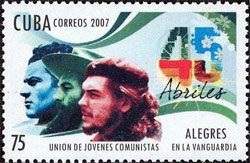 |
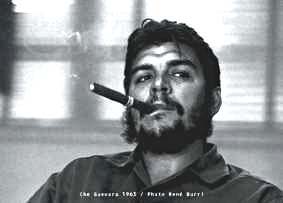 |
When they were given trials, they were showy public farces. When those found guilty were executed, they were executed publicly by firing squad. Their friends and families were paraded in front of the bloody wall. Guevara is said to have signed between 500 and “several thousand” death warrants, though the exact number may never be known. His own count was about 2,500. When they were not given trials, they were bound, gagged, psychologically broken, and then perhaps shot. The number killed without death warrants is unknown.
In case any still existed outside the camps who opposed the regime, he helped set up a secret police force and the "Committees for the Defense of the Revolution", another office for spying on and manipulating the Cuban population.
Guevara is largely known thanks to his failed attempts to export communism to other countries, like Congo, Bolivia and Argentina. Here is what a military says: "The Bolivian insurgency attempt also provides valuable insights into methods used by the USSR and Cuba to export revolution in third world countries. The actual campaign in Bolivia represents only the revolutionary "tip of the iceberg", portraying an aborted, ineffective guerrilla war while masking years of planning and preparation by Che and his mentor in Cuba, Fidel Castro. ... The insurgency that was intended to spark a hemispheric revolution lasting seven to ten years failed after only eleven months. Che Guevara's attempt to artificially create a "Vietnam" in Bolivia was a fascinating gamble. "
Most of the propaganda stamps shown on this page were issued by Cuba. A FDC was issued by Argentina and a sheet by Guinea Republic. The last set of 4 stamps, shown above, was issued in 2007 by the Cuban PA. It commemorates the "40th anniversary of the fall in combat of Che". Just another propaganda twist for a executioner who was executed while he was imprisoned by the Bolivian army.
Update. To commemorate the 50th death anniversary of Guevara, the Ireland post issued the shown above stamp and FDC. In announcing the stamp, An Post described Guevara as an “Argentinian Marxist revolutionary,” and also as a “doctor, an author, a guerilla, a diplomat and a military theorist.” In the bulletin Irish Stamps, The Collector, Joanne Ferris of An Post pointed out two Irish connections to Guevara: “Did you know that Che Guevara was of Irish descent and that his ancestors actually hailed from the Kilkee area of West Clare. Ireland’s very own Jim Fitzpatrick created the instantly-recognisable black and red image of Che Guevara that you see on t-shirts and in posters on student walls everywhere has since become one of the world’s top 10 most iconic images.” That 1968 image by Fitzpatrick is featured on the new stamp.
On Monday morning, Oct. 9, Ninoska Perez, a Cuban-American journalist and public commentator at Univision Radio, spoke on Ireland’s RTE national public service broadcaster, saying of the stamp, “It doesn’t matter that it’s an image created by an artist, it’s the image of a murderer.” The Irish Post also reported on Irish politicians who had voiced their complaints on social media. For example, Independent politician Paddy Manning tweeted: “An Post, the Irish postal service, has issued a stamp of mass murdering Argentinian Marxist, Che Guevara. " One Irish senator, Neale Richmond, said Guevara was “a barbaric interrogator, jailer and executioner of hundreds of supposed ‘class enemies.’" He added, “it is my belief that he is most definitely not a suitable candidate for such an honor.”
Link: linns.com
Created:
12/18/05. Revised: 01/03/2024 . |
